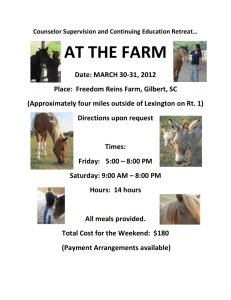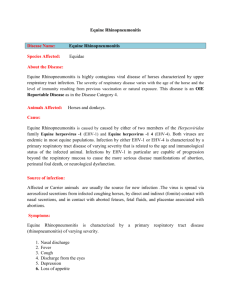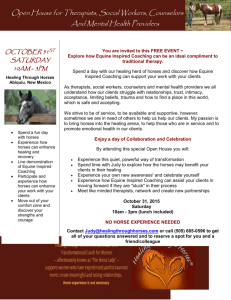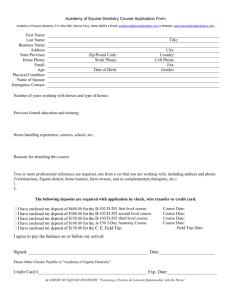international breeders` meeting
advertisement
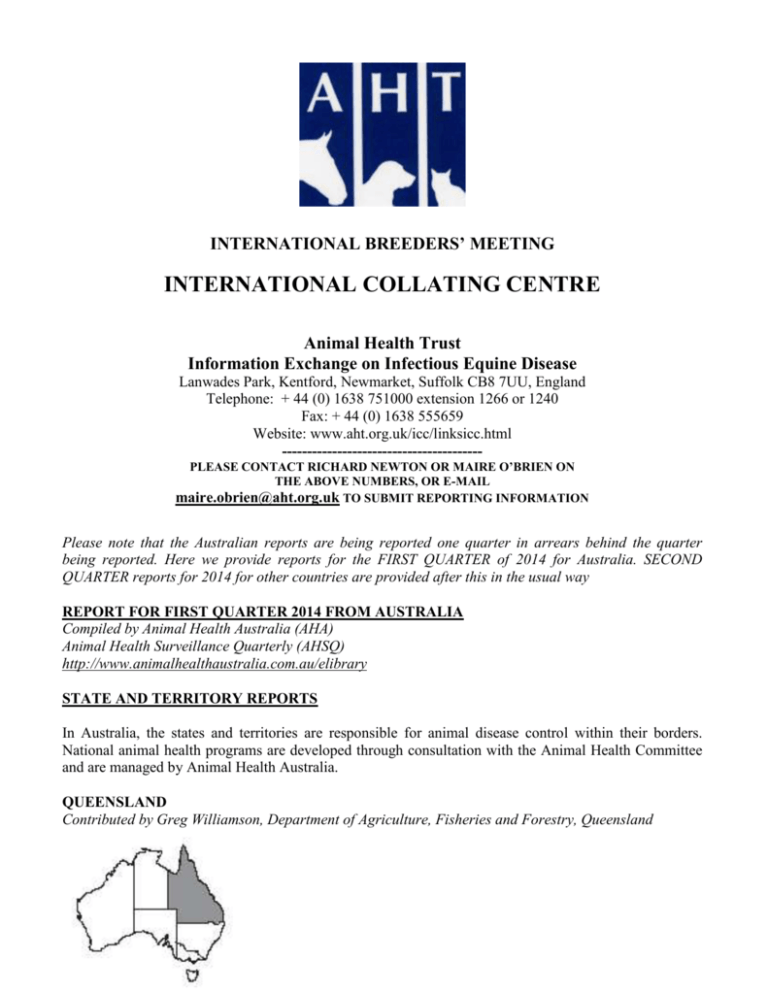
INTERNATIONAL BREEDERS’ MEETING INTERNATIONAL COLLATING CENTRE Animal Health Trust Information Exchange on Infectious Equine Disease Lanwades Park, Kentford, Newmarket, Suffolk CB8 7UU, England Telephone: + 44 (0) 1638 751000 extension 1266 or 1240 Fax: + 44 (0) 1638 555659 Website: www.aht.org.uk/icc/linksicc.html ---------------------------------------PLEASE CONTACT RICHARD NEWTON OR MAIRE O’BRIEN ON THE ABOVE NUMBERS, OR E-MAIL maire.obrien@aht.org.uk TO SUBMIT REPORTING INFORMATION Please note that the Australian reports are being reported one quarter in arrears behind the quarter being reported. Here we provide reports for the FIRST QUARTER of 2014 for Australia. SECOND QUARTER reports for 2014 for other countries are provided after this in the usual way REPORT FOR FIRST QUARTER 2014 FROM AUSTRALIA Compiled by Animal Health Australia (AHA) Animal Health Surveillance Quarterly (AHSQ) http://www.animalhealthaustralia.com.au/elibrary STATE AND TERRITORY REPORTS In Australia, the states and territories are responsible for animal disease control within their borders. National animal health programs are developed through consultation with the Animal Health Committee and are managed by Animal Health Australia. QUEENSLAND Contributed by Greg Williamson, Department of Agriculture, Fisheries and Forestry, Queensland 2 Hendra virus in a horse at Bundaberg During the quarter, 92 equine submissions for Hendra virus (HeV) disease investigation were made to Queensland's Biosecurity Science Laboratory. A further 16 submissions were made for health testing to exclude HeV in clinically well horses before interstate or international movement, movement to stud, or veterinary procedures that posed a high risk of disease transmission. There was one incident of HeV infection, at a property in the Bundaberg Regional Council. In mid-March, a five-year-old quarterhorse mare was initially off food and pyrexic (41 °C). Despite symptomatic treatment, it deteriorated over three days, developing respiratory signs (tachypnoea) and injected gums, leading to euthanasia. There was a frothy postmortem nasal discharge. Horses on the property were not vaccinated against HeV. Several dogs and unvaccinated horses that were assessed as having had potentially infectious contact with the infected horse on the same property and a neighbouring property were quarantined, monitored and tested. These animals remained clinically well, and three rounds of PCR and serological tests were negative for HeV. The quarantines were lifted in mid-April. All other HeV investigations during the quarter were negative. It is important that veterinarians and horse owners consider HeV infection and take appropriate precautions for any sick horse, even if signs are vague or mild. Veterinarians should ensure that appropriate infection control measures (including personal protective equipment) are used when dealing with sick horses where HeV infection may be involved. Veterinarians should also provide information to horse owners to ensure their personal safety and animal biosecurity while waiting for HeV diagnostic test results. Advice for veterinarians and horse owners for dealing with and preventing HeV in horses is available from www.biosecurity.qld.gov.au. Vaccination is the single most effective way of reducing the risk of HeV infection in horses. Horse owners are advised to seek veterinary advice about vaccinating their horses. TASMANIA Contributed by Mary Lou Conway, Department of Primary Industries, Parks, Water and Environment, Tasmania Hendra virus ruled out A case of acute febrile disease in a seven-year-old Thoroughbred gelding was investigated in the Geeveston district, south of Hobart, as part of an ongoing surveillance project in horses. The horse had a history of chronic ill-thrift since retiring from racing two years earlier, despite supplementation and regular worming. However, his condition had improved somewhat over the past three months. This report is based on information received by the Animal Health Trust, Registered Charity Number 209642, which cannot accept any responsibility for the accuracy or completeness of such information. 3 Two days before euthanasia, the horse had signs consistent with a mild upper respiratory tract infection. The horse’s condition deteriorated, despite nursing. He was examined by a private veterinarian and found to be suffering from acute respiratory distress, and was euthanased on welfare grounds after blood samples were collected. White, frothy nasal discharge was observed after euthanasia. Three other horses on the property were healthy at the time of the event. Since there was no history of contact with horses recently introduced from mainland Australia, and since Tasmania does not have an endemic flying fox population, the risk of Hendra virus was considered very low. A limited necropsy was therefore conducted by departmental staff to establish the primary abnormality. Pleuropneumonia and excessive pericardial fluid were observed on gross pathology. All other organs appeared normal. There was no evidence of vasculitis. Hendra virus was excluded on PCR testing at the CSIRO Australian Animal Health Laboratory. A necrotising alveolitis and myocarditis of unknown cause were diagnosed on histology. The pathology was consistent with viraemia, bacteraemia or circulating toxins such as polyether ionophores. At the time, no toxic plants were found, and stockfeeds on the property did not include monensin - a common type of polyether ionophore - in their contents lists. Given the ill-thrift history, this may have been the culmination of an ongoing cardiac abnormality. WESTERN AUSTRALIA Contributed by Jamie Finkelstein, Department of Agriculture and Food Western Australia Investigation of neurological signs - Hendra virus excluded In February 2014, DAFWA was notified by a private veterinarian in the Derby–West Kimberley region of a horse showing clinical signs suggestive of Hendra virus infection, including blood-tinged nasal discharge, muscular fasciculations and ataxia. Hendra virus infection has never occurred in Western Australia. Hendra virus infection was thought to be possible because of: critical aspects of the history, which revealed that the affected horse had shown no clinical signs the preceding night, but within 12 hours developed an elevated temperature, rapidly deteriorated and became recumbent, and then died identification of a number of risk factors for exposure to Hendra virus, including mango trees in paddocks and a recent history of fruit bats on the property. Minimally invasive samples were taken and submitted to CSIRO-AAHL for Hendra virus exclusion. While the results were pending, DAFWA implemented a number of risk mitigation measures, including isolating the in-contact horse and quarantining the property. Several people had potentially had close contact with the horse in the preceding days. The Western Australian Department of Health was notified, This report is based on information received by the Animal Health Trust, Registered Charity Number 209642, which cannot accept any responsibility for the accuracy or completeness of such information. 4 to provide assistance to these people while they waited for laboratory results from the horse. Laboratory testing was negative for Hendra virus. No other diagnosis was made based on the minimal sample set. DAFWA continues to advise the horse industry on the risk factors for Hendra virus infection and of the measures that can be implemented on properties to minimise the likelihood of introduction of the disease. NEW SOUTH WALES - Nothing to report VICTORIA - Nothing to report SOUTH AUSTRALIA - Nothing to report NORTHERN TERRITORY - Nothing to report REPORT FOR THE SECOND QUARTER 2014 ARGENTINA Equine Herpes Virus (EHV-1) Abortion A single case of EHV-1 abortion in a Thoroughbred mare was reported on 23rd June 2014 with diagnosis confirmed by Virology Institute, INTA Castelar. The aborting mare shared a paddock with 19 other pregnant mares, which were all in the last trimester of gestation but with no further abortions noted to date. No premonitory signs, sequelae or neurological signs were observed. EHV-1 infection was confirmed by discriminative real time PCR, with the infecting strain typed as the non-neuropathogenic variant (A2254/N752). AUSTRALIA As reported above, the FIRST quarter 2014 report for Australia is provided above. CANADA Equine Infectious Anaemia (EIA) Between 1st April 2014 and 30th June 2014, there have been a total of 26 EIA positive equines identified in the province of Saskatchewan on 10 separate premises. Two of the 10 premises were part of ongoing 2014 disease investigations. Four of the 10 premises had been affected in previous years; two in 2011 and two in 2012. All EIA infections were confirmed on the basis of Agar Gel Immuno Diffusion (AGID; Coggins) serology. CHILE Regret no report received. DENMARK Strangles (Streptococcus equi) Two outbreaks of strangles were reported during the second quarter in riding stables near Copenhagen. The first occurrence was reported at the end of April with the last case reported at the end of June. The This report is based on information received by the Animal Health Trust, Registered Charity Number 209642, which cannot accept any responsibility for the accuracy or completeness of such information. 5 outbreaks on the two premises have involved between 50 and 100 horses, of which 25% are reported to have been affected. Positive diagnoses were made by agent isolation. FRANCE (Information supplied via the RESPE, the French network for epidemiosurveillance of equine diseases) Equine Herpes Virus-1 (EHV-1) Abortion Five outbreaks of EHV-1 abortion have been confirmed this quarter in Calvados, Doubs, Orne, Bas-Rhin and Tarn-et-Garonne and were known to involve Thoroughbreds in one outbreak and French Saddlebreds in another. Positive diagnoses were made by PCR on fetal organs or placentae. Equine Herpes Virus-1 (EHV-1) Neurological Disease On 16th May 2014, one outbreak of EHV-1 neurological disease was confirmed in Vendée. The affected horse was an unvaccinated mare used in a riding school that presented with clinical signs of weariness, ataxia and stiffness. Positive diagnosis was made by PCR on blood. Equine Herpes Virus-1 (EHV-1) Respiratory Disease Nine outbreaks of EHV-1 respiratory diseases have been confirmed in Calvados, Eure-et-Loir, Ille-etVilaine, Isère, Loire-Atlantique and Oise and were known to involve French Trotters in two outbreaks and French Saddlebreds in another two outbreaks. Affected horses showed a variety of clinical signs including fever, nasal discharge, coughing, respiratory syndrome and dyspnoea. Positive diagnoses were made by PCR on nasopharyngeal swabs or tracheal washes. Equine Influenza (EI) Two outbreaks of EI have been confirmed in Seine-et-Marne, including one involving a Shetland pony imported from The Netherlands. Affected animals showed a variety of clinical signs including fever, nasal discharge and coughing. Positive diagnoses were made by PCR on nasopharyngeal swabs. Equine Viral Arteritis (EVA) A single subclinical case of EVA was diagnosed by PCR in the semen of an eight year-old Holstein on a premises in Aveyron. Piroplasmosis Remains endemic in France. Strangles (Streptococcus equi) Thirteen outbreaks of strangles have been reported this quarter Calvados, Hérault, Indre-et-Loire, Lot, Maine-et-Loire, Manche, Orne, Tarn-et-Garonne, Essonne and Val-de-Marne and involved French Trotters in three outbreaks and in Thoroughbreds, French Saddlebreds, Saddlebreds and Arab, each on individual premises. Affected horses showed clinical signs that included lymphadenopathy, fever, nasal discharge coughing and weariness. Positive diagnoses were made by PCR on nasopharyngeal swabs or purulent nasal discharge samples. GERMANY Results received from Labor Dr Boese GmBh – a HBLB CEMO approved laboratory Contagious Equine Metritis (CEM) CEM was confirmed in 11 non-Thoroughbreds (five stallions and six mares) on 10 premises with diagnoses by bacterial isolation of Taylorella equigenitalis and by PCR on genital swabs. This report is based on information received by the Animal Health Trust, Registered Charity Number 209642, which cannot accept any responsibility for the accuracy or completeness of such information. 6 Equine Herpes Virus-1 (EHV-1) Five cases of EHV-1 associated disease were confirmed on five premises. These included a single case of abortion with diagnosis by PCR on uterine discharge and lung puncture aspirate; a single case of a weak non-viable foal with diagnosis by PCR on lung puncture aspirate; a single case of fever and ataxia with diagnosis by PCR on nasopharyngeal swab involving a non-neuropathogenic strain of EHV-1 and two cases with no clinical description available with diagnoses confirmed by PCR on nasopharyngeal swab and both involving non-neuropathogenic strains of EHV-1. Equine Herpes Virus-4 (EHV-4) Respiratory Disease Respiratory disease due to EHV-4 infection was confirmed in five horses on five premises by PCR on nasal swabs. Equine Viral Arteritis (EVA) Equine viral Arteritis (EVA) was confirmed in one non-Thoroughbred stallion with the positive diagnosis made by PCR on a semen sample. No further details are currently available. Salmonella spp. Salmonella was confirmed in a four-year-old gelding with the positive diagnosis made by bacterial culture and PCR on faecal samples. Strangles (Streptococcus equi) Strangles was confirmed in seven horses on five separate premises. No clinical descriptions were available, although strangles had been suspected in all cases. Four cases were diagnosed by bacterial culture and PCR on nasal swabs; two cases were diagnosed by bacterial culture and PCR on swabs from abscess material and one further case was confirmed by bacterial culture and PCR on a swab taken from a guttural pouch wash. Equine Anaplasmosis (Anaplasma phagocytophilum) A single case of anaplasmosis was confirmed with diagnosis by PCR on EDTA whole blood. HONG KONG Confirmed nothing to report. IRELAND (Republic of) Regret no report received. ITALY Regret no report received. JAPAN Equine Herpes Virus-1 (EHV-1) Neonatal Foal Death A single case of EHV-1 neonatal foal death in a non-vaccinated Thoroughbred was confirmed on 1st May 2014. The confirming laboratory was Hokkaido Hidaka Livestock Hygiene Service Centre with diagnoses by agent isolation. This report is based on information received by the Animal Health Trust, Registered Charity Number 209642, which cannot accept any responsibility for the accuracy or completeness of such information. 7 Tetanus A single case of tetanus in a non-vaccinated Thoroughbred that was euthanased was confirmed on 3rd April 2014. The clinical diagnosis was made by the Hokkaido Hidaka Livestock Hygiene Service Centre. NEW ZEALAND Confirmed nothing to report. SINGAPORE Confirmed nothing to report. SOUTH AFRICA Confirmed nothing to report. SOUTH KOREA Confirmed nothing to report. SPAIN Regret no report received. SWEDEN Regret no report received. SWITZERLAND Equine Anaplasmosis (Anaplasma phagocytophilum) Two separate cases of anaplasmosis were reported in April and June of the first quarter, with diagnoses made by agent isolation. Salmonellosis A single case of Salmonella was reported on 25th May 2014 with diagnosis made by agent isolation. Strangles (Streptococcus equi) Two separate outbreaks of strangles affecting three horses were reported in April and May of the first quarter, with diagnoses made by agent isolation. TURKEY Regret no report received. This report is based on information received by the Animal Health Trust, Registered Charity Number 209642, which cannot accept any responsibility for the accuracy or completeness of such information. 8 UNITED ARAB EMIRATES (UAE) Piroplasmosis (Theileria equi and Babesia caballi) Piroplasmosis is endemic in the UAE with clinical cases reported periodically. The confirming laboratory is Central Veterinary Research Laboratory Dubai using serology and agent isolation. Strangles (Streptococcus equi) The strangles outbreak which commenced on 28th December 2013 is now considered resolved. In all, 77 horses on nine premises were affected. However, two more cases were detected in horses in quarantine in a shipment from the USA. The confirming laboratory was Central Veterinary Research Laboratory Dubai by serology and agent isolation. UNITED KINGDOM Please note that all UK cases and outbreaks have already been notified via interim reports during the third quarter and since. UNITED STATES OF AMERICA Adenovirus Infection A single case of adenovirus infection was confirmed in a foal. No further details are available. Clostridial enteritis Isolated cases of enteritis associated with Clostridium difficile, Toxin A gene (two cases), and C. difficile, Toxin B gene (two cases) were recorded. Also, C. perfringens Type A enterotoxemia was diagnosed in eight foals. Equine Infectious Anemia (EIA) In late June, EIA was diagnosed in a horse on a premises in Wyoming. The infected animal was euthanased. Initial testing of all other equids on the affected and adjacent premises has not detected any additional cases. Eastern Equine Encephalomyelitis (EEE) A total of 13 equine cases of EEE have been confirmed during the second quarter. Twelve cases were confirmed in Florida and one case in Georgia. Equine Herpes Virus (EHV) There continues to be serological evidence of circulation of EHV-1 and EHV-4 in the US equid population. A total of seven isolated cases of EHV associated abortion were known to have occurred, all in Kentucky. The second quarter of 2014 saw a significant number of outbreaks of EHV-1 neurological disease involving premises in Wisconsin (one case), Virginia (one case), N. Dakota (one case), Pennsylvania (two cases), Kansas (one case), S. Dakota (one case), Colorado (two cases) and Massachusetts (one case). The vast majority of cases of the disease were associated with nonneuropathogenic strains of the A2254 genotype of EHV-1. Quarter horses were primarily involved with many of the cases linked to exposure at barrel racing events. Equine Herpes Virus-3 (EHV-3) Coital exanthema) EHV-3 infection was confirmed in two horses in Kentucky. This report is based on information received by the Animal Health Trust, Registered Charity Number 209642, which cannot accept any responsibility for the accuracy or completeness of such information. 9 Equine Herpes Virus-2 (EHV-2) and Equine Herpes Virus-5 (EHV-5) A limited number of cases of infection with EHV-2 (six in Kentucky and one in Wisconsin), and EHV-5 (one in Kentucky) were confirmed during the second quarter of 2014. Equine Influenza (EI) Equine influenza is endemic in the USA, with sporadic outbreaks occurring not all of which are reported. An outbreak was confirmed in Texas during the second quarter of 2014. Equine Piroplasmosis (EP) The national EP situation continues to be monitored by the USDA, APHIS, VS. A number of additional cases of Theileria equi infection were identified in California, Florida and Texas. All horses involved were among high-risk groups of Quarter horse racehorses especially engaged in non-sanctioned racing, previous imports and illegal imports from Mexico. California confirmed one clinical case, positive for EP and equine infectious anemia (EIA), at a bushtrack premises and two additional EP positive horses and a seropositive stallion on a second premises. The history indicated introduction of horses from Mexico. Florida reported three EP positive horses, all imported animals and Texas confirmed infection in two horses at a bushtrack that were probablyu imported illegally from Mexico. Nocardioform placentitis and abortion A single case of abortion associated with Amycolatopsis spp infection was confirmed in Kentucky. Rhodococcus equi Pneumonia due to Rhodococcus equi is an endemic disease in the US equine population. While the disease is underreported, documented outbreaks have occurred in Kentucky. Salmonellosis A limited number of outbreaks of Salmonella were reported, seven associated with strains of Group B Salmonella spp, and two with Group C1 strains. Strangles (Streptococcus equi) Strangles is endemic in the USA, with cases/outbreaks reported from at least 15 states. The number of affected premises and horses that were documented were 38 and 66, respectively. Seven confirmed outbreaks involved multiple cases of the diseases on individual premises in Connecticut, Kentucky, N. Carolina, S. Carolina and New York. Vesicular Stomatitis (VS) Vesicular stomatitis was confirmed on 23rd May, 2014 in Southeast Texas. Infection with the New Jersey serotype of the virus was diagnosed in two horses on a premises in Kinney County. Up to end of the second quarter of 2014, a total of seven affected premises have been identified, all in Texas. All of the cases to date have been in horses located on premises in four countries within the state. West Nile Encephalitis (WNE) One case of WNE has been documented so far in 2014. It occurred in Alabama. VENEZUALA Regret no report received. This report is based on information received by the Animal Health Trust, Registered Charity Number 209642, which cannot accept any responsibility for the accuracy or completeness of such information. 10 REGARDS INTERNATIONAL COLLATING CENTRE (Total pages = 10) This report is based on information received by the Animal Health Trust, Registered Charity Number 209642, which cannot accept any responsibility for the accuracy or completeness of such information.

